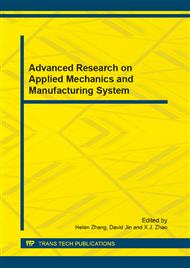p.27
p.32
p.36
p.40
p.44
p.51
p.56
p.60
p.64
Rational Position of Apparatus for Removing Cotton Foreign Fiber in Dynamic Equilibrium
Abstract:
Cotton processing technology in an automatic production line was presented. A pipeline used to set an apparatus for removing the foreign fiber was chosen in the cotton processing technology. The distribution and velocity of the cotton in five positions of the central plane of the pipeline were simulated by the Fluent software. The simulated curves of the cotton distribution and velocity were obtained. According to the curves, there is the optimal length of the cotton conveyed pipeline with a certain cross-section area to set the apparatus for removing the foreign fiber. There is no the steady zone if the pipeline length is shorter than the optimal value, and if longer than it, the pipeline will waste the material and space. The steady zone is determined by the forces. In the certain position of the straight pipeline away from the curved pipeline, the various forces, which act on the cotton or foreign fiber, are in the dynamic equilibrium, and the distribution and velocity of the cotton are steady. For the rectangular pipeline with the cross-section area 2960×120mm , its total length should be 7000mm, the steady zone length of the cotton distribution is about 2500mm, and the steady zone of its velocity is 1000mm. In the common part of their steady zones the apparatus for removing the foreign fiber may be setting rationally.
Info:
Periodical:
Pages:
44-50
Citation:
Online since:
December 2012
Authors:
Keywords:
Price:
Сopyright:
© 2013 Trans Tech Publications Ltd. All Rights Reserved
Share:
Citation:


